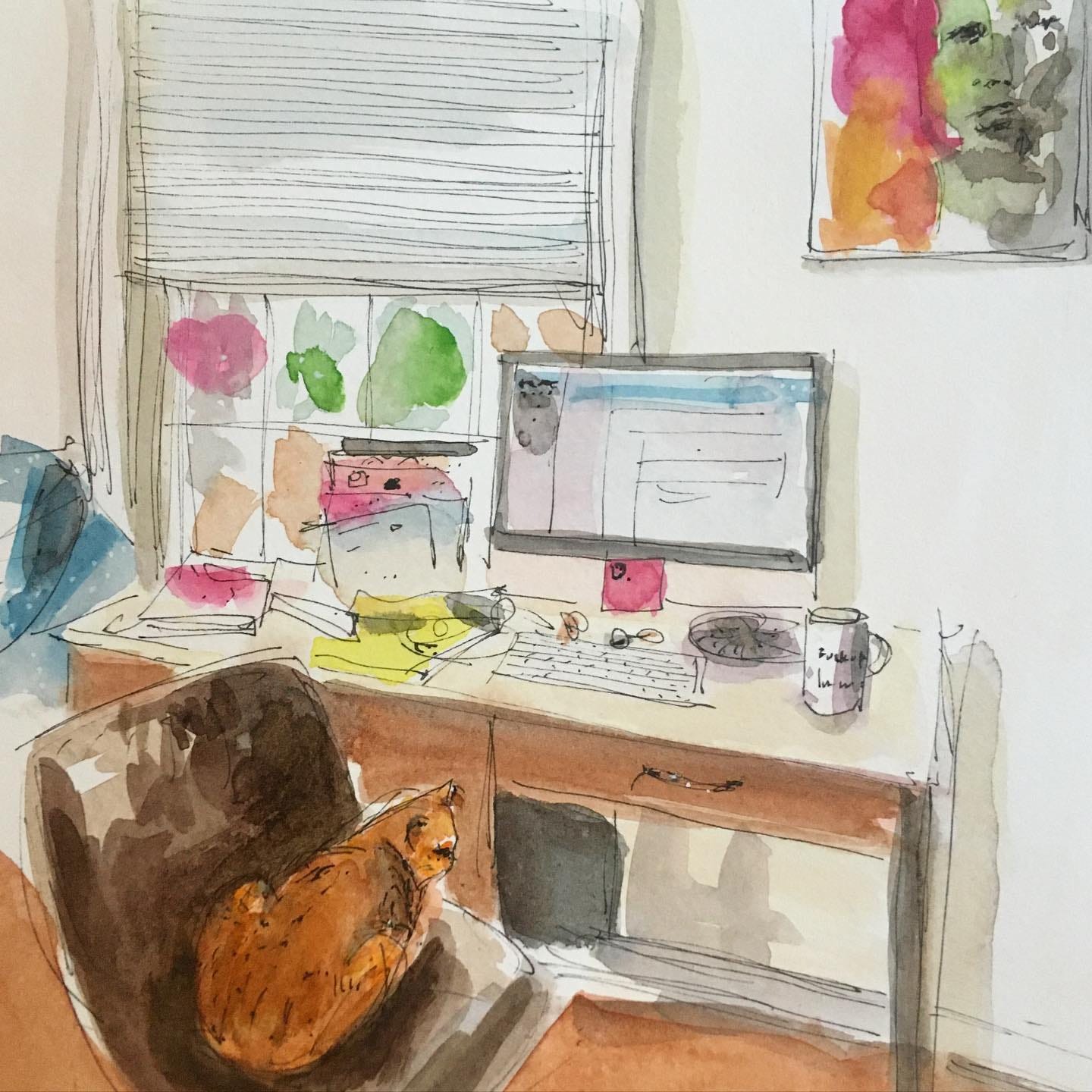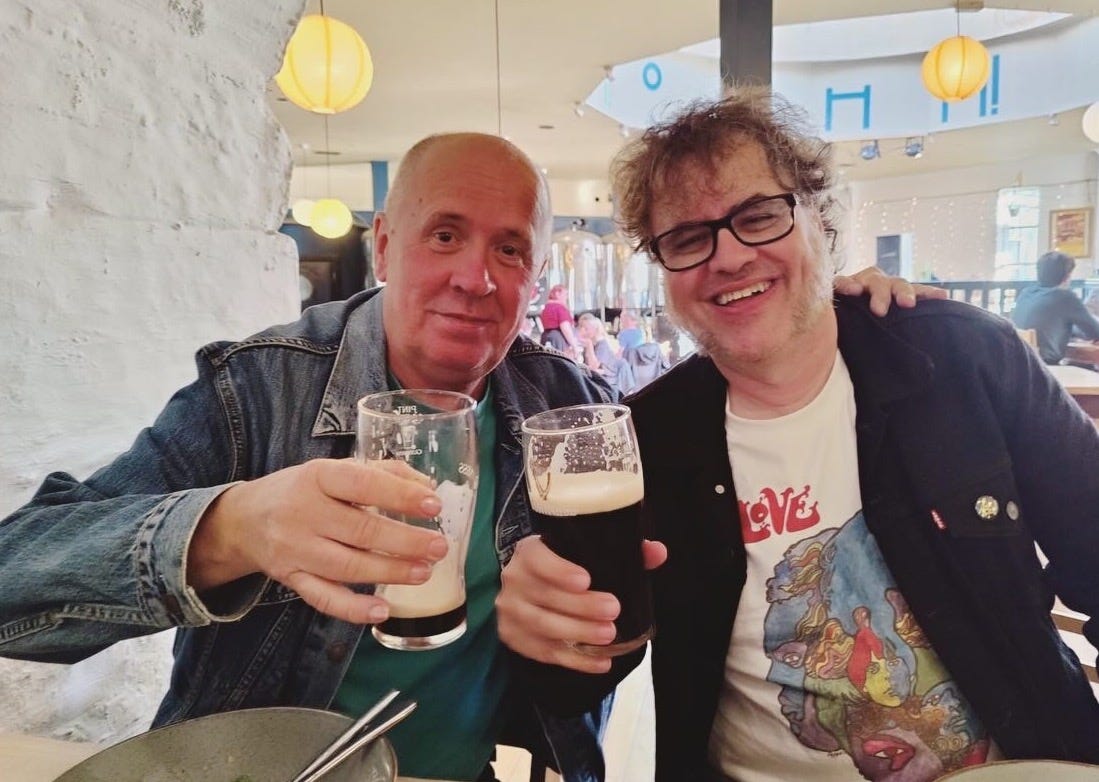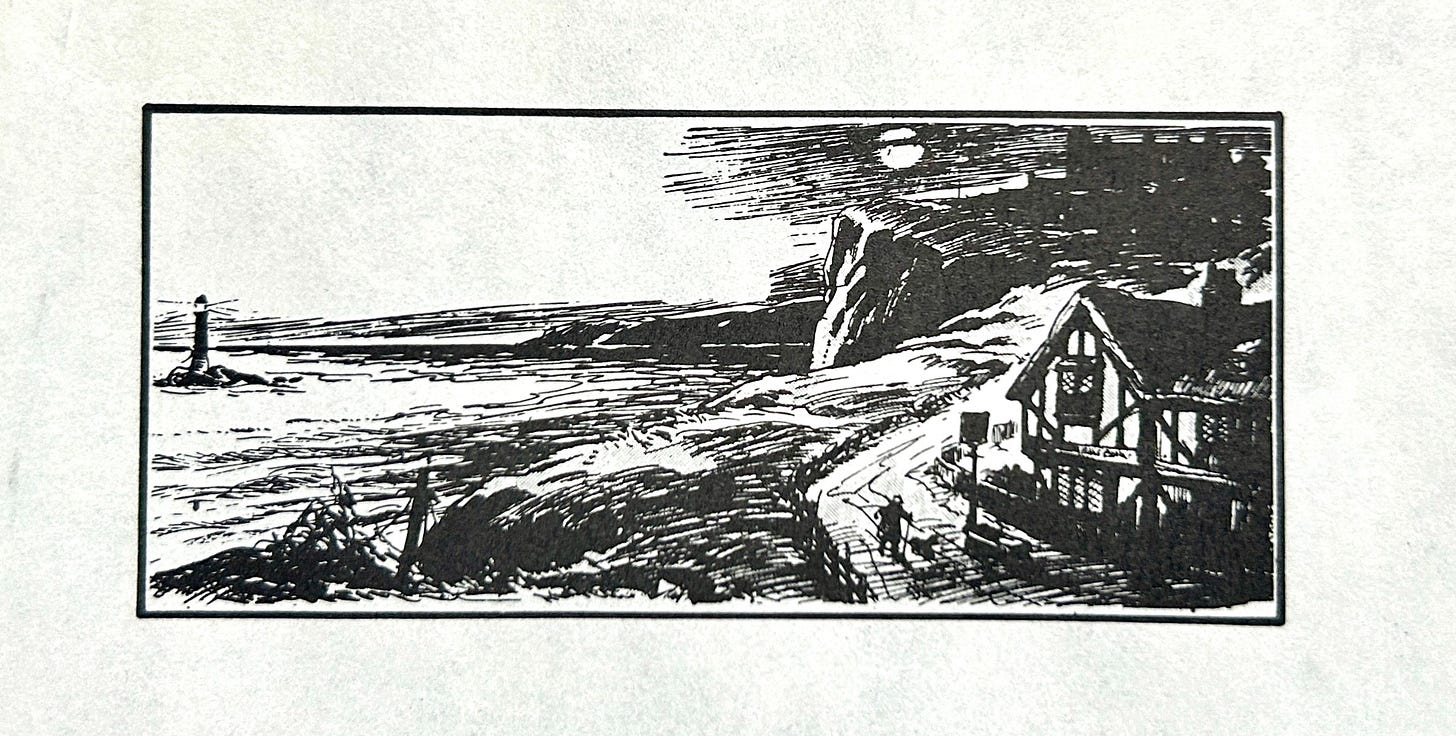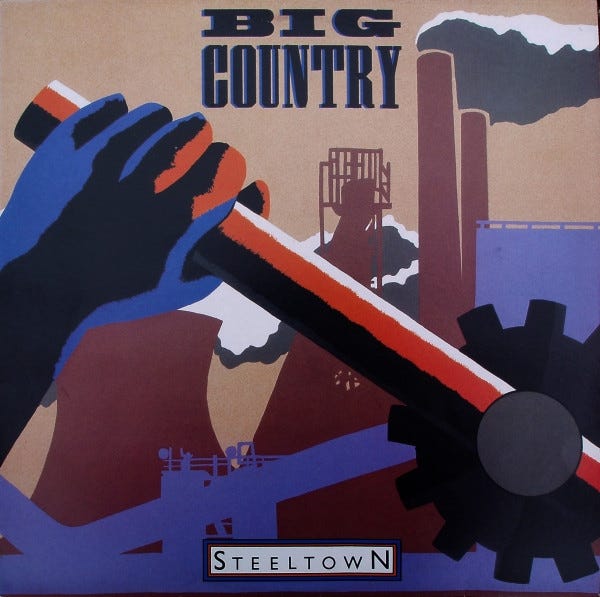Greetings, Jagged Time Lapsers!
I deeply appreciate all of you who patiently stuck around — and the dozen or so of you who became new subscribers — while I was away on vacation in Scotland… an absence which was extended while I was forced to deal with an unpleasant surprise upon my return (more on that in a sec). But now I’m back, refreshed, and ready to fire this thang up again. Let’s rock!
This was my first time north of Hadrian’s Wall, and I absolutely adored it. Scotland is a strikingly beautiful country, and just about everyone my girlfriend Shannon and I met on our travels was as warm and welcoming as their nation’s history is bloody and complex. We both felt more at home there than either of us have ever felt in any country we’ve previously visited.
(However, the jagoff who hacked my debit card and drained most of my checking account while we were away can go fellate a rotten haggis. Hopefully my bank will cover the bogus charges, but my next few weeks are certain to be something of an adventure in modern living while I wait for them to sort through the mess. So hey, if any of you free subscribers have been thinking about upgrading to a paid JTL subscription, now would be a most excellent time to do so. Thanks in advance!)
Our heads are still spinning as we try to process all the amazing sights we saw in Scotland, the magical moments we experienced, and the uproarious laughs we shared with dear friends old and new. We didn’t have time to see most of the Highlands or any of the western islands that everyone raves about, but it didn’t matter — we fell completely under the country’s enchanting spell within our first couple hours of arrival, when a rainy and romantic late-afternoon walk through Edinburgh’s gorgeous Princes Street Gardens led us to an unexpected encounter with St. Cuthbert’s Kirkyard. Giddy at being in a new city, and feeling slightly punchy after having slept for only a few hours on the redeye over, we marveled at the gorgeous and otherworldly scene of the mossy headstones crumbling in the shadow of Edinburgh Castle. And our trip just got better from there…

I’d been wanting to visit Scotland since 1974, when my dad, sister and I lived for a time in the English town of Leamington Spa. I didn’t know much about England’s northern neighbor at the time, other than that the ancient Romans had failed in their attempts to conquer it, and that there were tons of old castles up there (not to mention the Loch Ness monster), but somehow I still felt its gravitational pull. Alas, we simply ran out of time to get up there before moving back to the States.
But it was the release of The Crossing, Big Country’s debut album from 1983, that really intensified my interest in Scotland in general, and in Scottish music in particular. Up until I heard the band’s song “Chance” on a late-summer broadcast of the syndicated radio show Rock Over London, I’d never really given much thought to the notion that there might be bands from Scotland that were as vital as the ones I loved from England — or that, despite their geographical proximity to English bands, Scottish bands might possess a somewhat different sensibility. But Rock Over London DJ Graham Dene’s description of Big Country as sounding “like Bruce Springsteen with bagpipes” certainly grabbed my attention; on my next trip to downtown Chicago, I stopped in at Rolling Stone Records to picked up a copy of The Crossing.
I was completely smitten with The Crossing from the moment my turntable needle hit the wax. The martial drums, the rousing vocals, the droning “bagpipe guitars” (achieved in part by Stuart Adamson and co-lead guitarist Bruce Watson running their axes through MXR M-129 Pitch Transposers), the tersely poetic lyrics that spoke of noble perseverance in the face of violence, loss, deprivation and the elements, and the uncredited but extremely evocative inner-sleeve illustrations like the one above — it all resonated deeply in my soul, “Like a lover’s voice fires the mountainside,” as Adamson sang on “In a Big Country,” which became the band’s lone Top 20 US hit.
My favorite tracks, then as now, were “In a Big Country,” the mournful “Chance,” the swirling epic “The Storm” and the stomping “Fields of Fire (400 Miles)”. Even more than R.E.M.’s Murmur, The Crossing was my favorite LP of 1983, and probably still is; nothing takes me back to the damp and chilly autumn of my senior year in high school — or my first fumbling attempts at experimenting with guitar drones — like this album.
By the fall of 1984, I was working around the corner from Rolling Stone Records, which meant that I could run out on my lunch break and pick up the latest hotly-anticipated album on the day of its release. I was among the store’s first customers to buy Steeltown, the follow-up to The Crossing, when it dropped in the US on October 29, two weeks after it had been released in the UK.
This lag time between release dates meant that I’d already read reviews of the album in the British music weeklies Melody Maker and New Musical Express. As I recall, their takes on Steeltown weren’t particularly favorable (Big Country had become a huge success in the UK, which meant that they were now primed for the British press to chop them down) but I was both amused and intrigued by one reviewer’s assertion that the album’s lyrics all sounded like they’d been written at least a hundred years earlier. He’d obviously meant this as a snarky dig, but it was actually exactly the sort of thing I wanted out of Big Country — a sense of being transported to another time and place.
I dug Steeltown a lot, though not as much as The Crossing. Like its predecessor, it was filled with powerful, evocative songs — “Flame of the West,” “Tall Ships Go” and “Just a Shadow” were my faves — but producer Steve Lillywhite had really slathered on the state-of-the-art effects this time out, burying the songs in a digital murk that sounded pretty cold and unappealing in comparison to the refreshing rawness of the latest records from The Del-Lords, The Replacements and Hüsker Dü, my three new favorite American bands of that moment.
Still, I kept Steeltown in regular rotation that fall and winter. That New Year’s Eve, I amused (and doubtless appalled) my fellow partygoers by drunkenly quoting many of the album’s lyrics — with several repetitions of “We will find the newborn year/As winter crashes down!” from “Rain Dance” — as well as excerpts from Stuart Adamson’s recent NME interview in my best approximation of his semi-indecipherable Dunfermline brogue. It wasn’t my proudest moment, and such behavior probably would have gotten me stabbed in any self-respecting Scottish pub. But it was meant lovingly; and hey, I was only eighteen at the time…
I got off the Big Country train at 1986’s The Seer, which was even more festooned with gaudy mid-eighties bells and whistles than Steeltown. But that was okay, because Big Country already had more than done their job by sending me on a an exploratory journey into Scottish rock music. Said journey began with me digging through the import bins to find albums by Adamson’s previous band The Skids — as great as that band’s seminal 1979 debut LP is, 1980’s Bill Nelson-produced Days in Europa is still my sentimental favorite — and eventually led me to the brilliant likes of Aztec Camera, The Waterboys, Orange Juice, The Fire Engines, The Jesus and Mary Chain (having no idea that I would eventually contribute to their fractious breakup), Primal Scream, Jasmine Minks, The Primevals, Teenage Fanclub, The Vaselines, The Pastels, BMX Bandits, 18 Wheeler, Belle and Sebastian and many others, as well as propelling me back in time to records by such Scottish folk luminaries as Donovan, Bert Jansch and The Incredible String Band. (Not to mention such seventies heroes as The Bay City Rollers and The Sensational Alex Harvey Band!)
All of these records painted a picture for me of Scotland as a place of fertile and proudly defiant creativity, where drawing upon personal vision, a wry sense of humor and/or Scotland-specific cultural/historical references were far more important than fitting in with whatever trends the London-based music weeklies happened to be hyping.
Which is why I was so surprised at the almost total absence of homegrown sounds during last week’s visit to Scotland. Sure, there was bagpipe music to be heard in the streets and shops of Edinburgh’s Royal Mile, and we happily witnessed a traditional folk jam break out at the Last Drop pub on Grassmarket — but other than that, bland nineties and early-oughts pop from the other side of the pond seemed to be the prevailing musical flavor everywhere we went. (I mean, who wouldn’t want to hear the likes of Train, Shania Twain and Jimmy Eat World when you’re tucking into a steaming bowl of Cullen Skink and a freshly-pulled pint at a centuries-old Scottish pub, right?)
Worst of all was the soundtrack to our day-long bus tour to Hadrian’s Wall. Mac, our driver and guide, was a lovely bloke well-versed in Scottish history and lore, but his taste in music was heavy on the sort of bloodlessly generic brand of post-Bon Iver folk that makes Donovan sound like Motörhead. To be fair, some of it may have actually been Scottish — I had never heard most of the songs before — but they all made our long drive through the grey countryside exceptionally depressing. When Neil Young’s “Heart of Gold” finally popped up on his player right as we were pulling back into Edinburgh, it gave me such a rush of energy and relief that I practically punched my fist through the ceiling of our tour bus in celebration.
Thankfully, my friend Jim Doak totally came through with some serious Scottish jams on the last full day of our trip. How I’ve come to know Jimmy is a strange and wonderful story in itself, one that dates back four decades to my original dive into Scottish rock history…
Back in late 1983, I bought a paperback copy of The Trouser Press Guide to New Wave Records and proceeded to devour the whole thing from cover to cover; I was less interested in its writers’ takes on bands and records I was already familiar with than I was in discovering ones that I didn’t know about yet. This important tome was what initially hipped me to The Skids, as well as what put me on the trail of such future faves as The Undertones, The Soft Boys and The Rezillos, none of which I’d ever even heard of before picking up the book. And then there was this entry on a band called The Jolt:
Small wonder the Jolt was written off as a Scottish Jam clone. The mod trio of singer-guitarist Robert Collins, bassist Jim Doak and drummer Iain Sheddon had — what a coincidence! — the same label, producer, image, type of name and sound. They even played shows together in Glasgow. The Jolt’s album shows they could work up a good sweat, but the material is strictly two-dimensional, not a patch on even Paul Weller’s most derivative early work.
It didn’t matter that the Trouser Press review — written by Jim Green, whom I would wind up regularly playing Saturday softball with in L.A. during the late nineties and early oughts — was a less than enthusiastic one. For me, the magic words were “Scottish Jam clone”; I was so obsessed with The Jam in those days that anyone who had so much as touched the hem of Paul Weller’s boating blazer was of immediate interest to me.
Over the next several years, I would hit the “Various J” section in every used record store I entered, hoping to turn up The Jolt’s self-titled 1978 album. The closest I ever came was a copy of 20 of Another Kind, a fantastic 1979 comp from Polydor Records which rounded up recent tracks by such major punk/new wave acts as The Jam, The Skids, The Cure, Stiff Little Fingers, Generation X and The Stranglers, and also included The Jolt’s slashing “No Excuses” — a song I must have put on at least two-dozen mixtapes for friends after scoring the album from Chicago’s Reckless Records in the spring of 1990.
It wasn’t until 2002, when the Captain Mod label reissued the record on CD (along with a seven bonus tracks), that I was finally able to hear the rest of that Jolt album. And while it wasn’t the second coming of All Mod Cons, it was still more than worth the wait. A lot of bands from the UK mod revival of the late seventies — which The Jolt slightly preceded — were actually pretty bland and tepid, but The Jolt brims with fiery playing, infectious hooks, and the palpable excitement of three young men from a small Scottish iron and mining town heading to London to take on the world. It’s a shame they only lasted long enough to record an album, an EP and a handful of singles, but that’s still more than most bands ever manage to achieve.
Flash forward to February 2019, when my friend, colleague and fellow mod obsessive
posted a YouTube clip of The Jolt’s “Everybody’s The Same” on Facebook. A lively discussion ensued, and somebody tagged former Jolt bassist/vocalist Jim Doak and guitarist/vocalist Robert Collins to join in the fray.Social media has a veritable mountain of things to answer for, but allowing you to directly interact with the people responsible for records you love isn’t one of them. I sent Jimmy a friend request, and soon found that we had much in common — not just in terms of interests (music, film, books, art, etc.), but also a similarly open-hearted approach to life and a deep appreciation of its simple joys.
When I announced on Facebook in early 2020 that I was finally ready to wade back into the world of home recording and looking for recommendations on how to proceed (my Tascam Porta-2 having bitten the dust during the last Clinton administration), Jimmy was quite generous with his knowledge and encouragement. Following my first grapple with GarageBand — Jimmy had been one of several friends to suggest I go that route, since I already had a Mac — I posted a funky minute-long snippet of what would eventually become my Corinthian Columns track “Blue Diamond Fire”. “You should add a flute solo,” Jimmy commented. “Haha, nice joke,” I thought… and then I realized he was totally right, a realization which completely opened my mind to exploring the wild world of GarageBand loops and samples, and which has informed my “anything goes” approach to home recording ever since.
During pandemic lockdown, Jimmy nominated me for inclusion in the “Writer’s Desk” series of watercolor paintings being done by his wife, the immensely talented (and shockingly prolific!) author and artist
. I sent Fiona a photo of my workspace in my then-home of Greensboro, North Carolina, and she came up with this wonderful painting of it, complete with the recently-adopted Angus a.k.a. Tiny stealing my office chair. My time in NC was a rocky one, and there’s a lot of bad and sad memories associated with it; but I really loved that home office, and Fiona’s painting totally captured the sunlit joy I often felt while working in it. It’s now framed and hanging proudly in my upstate New York abode, not far from my current desk…
Earlier this year, when Shannon and I began planning our Scotland trip, Glasgow residents Jimmy and Fiona were the first folks I reached out to — both for recommendations on places to go and things to do, and because I really wanted to finally meet them in person. They just seemed like kindred spirits, y’know?
As it turned out, they not only generously offered to let us stay at their pad for a night, but also dangled the option of a quick car tour of Loch Lomond and the southwestern Highlands before we all went off to see Love Revisited with Johnny Echols play at St. Luke’s in Glasgow on our last evening in Scotland. “Wait, we’re staying with people you’ve never met?” asked Shannon, slightly taken aback at first. “Is Loch Lomond where Jimmy’s going to dump our bodies after he kills us?” “Probably,” I replied, “But at least we’ll die in a beautiful place!”
No blood was shed, as it turns out, and the four of us got along even more swimmingly than I’d anticipated. A warmer, funnier, more delightful couple you could not hope to meet, and — brilliant Love gig aside, where we also had the pleasure of hanging out with their Primevals pals Michael Rooney, John Honeyman and Ady Gillespie — we pretty much spent our entire time together gabbing like we’d all known each other for decades, and generally laughing our respective asses off. Shannon and I left Glasgow feeling like we’d truly made some friends for life, and we’re already plotting to show J&F a great time whenever they visit us in the States.

And, as mentioned earlier, Jimmy totally came through with the brilliant tunes during our drive. We were just a few minutes outside of Glasgow when I realized that every song on Jimmy’s playlist was a gem of Scottish extraction — Aztec Camera, Waterboys, Edwyn Collins, Belle and Sebastian, etc. It was the perfect soundtrack for a gorgeous, dreamlike (and occasionally rather hairy) afternoon ride that took us to Loch Lomond, Strathur, Otterferry, Dunoon and back to Glasgow via the Gourock Ferry.
With supernaturally perfect timing, “In a Big Country” came on just as we were making our way down the road to Loch Lomond. I had to interrupt our conversation in order to fully absorb the moment — and to hold back the tears that were welling in my eyes. To hear the very song that kickstarted my interest in Scotland’s rock music over forty years ago, at the very moment that one of the country’s most beautiful lochs hove into view, in a car driven by someone whose band I’d first read about in 1983 and had now somehow become a friend… well, to paraphrase the late, great Stuart Adamson, it felt like I’d unexpectedly grown some flowers in the desert.








Loved reading this so much Dan! So beautifully told. And it was so good to meet you and Shannon in person. Jim and I insist that you come back to 'do' the west - and perhaps even the very north! And for longer next time! x
Helluva read, Dan! Wonderful trip and stories. Happy that I had some small, albeit inadvertent, part in you and Jim connecting!